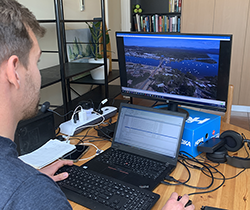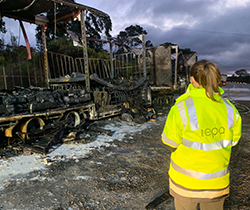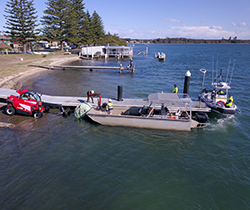Innovating in a Covid-19 world
During the state-wide lockdowns and restrictions due to COVID-19, the EPA has applied some innovative ways to ensure our important compliance and incident response work continues effectively and safely. EPA operational staff across the state have worked collaboratively, and often remotely, with licensees and community.

We are using virtual and remote methods to assist licensees with compliance during Covid-19
New checklist for virtual compliance checks
Director Regulatory Operations James Goodwin reports
During COVID the EPA has moved to virtual inspections which involve an EPA officer working remotely with representatives of a licensed facility to ask questions and discuss aspects of their operations.
To streamline the EPA’s virtual inspections, we have now developed a checklist to assist officers to prepare for and conduct remote inspections of licensed operations.
Our team compiled this checklist based on lessons learned and early virtual inspection experiences. This provides officers with a consistent approach to remote inspections and makes sure that we and licensees have pre-agreed expectations for how the inspection will happen, taking into consideration safety and the facility’s access to technology.
The inspections can range from live video inspections to online meetings with follow-up photos.
Licensees have let us know that they have found the opportunity to discuss site licensing matters with the EPA, despite lockdown, as helpful and positive.
They also appreciated us being conscious of the need for safe virtual inspections. For example, not sending live video of their site walk-around where they had to navigate active forklifts or other plant equipment and making sure our inspection could be conducted in a COVID-safe way.
Keeping responders and community safe

The EPA quickly attended the truck fire incident to advise on dangerous goods clean-up
Carlie Armstrong from Queanbeyan reports
The EPA continues to work with first responder agencies to major incidents in person during COVID-19 restrictions, requiring greater adaptability and an increased focus on safety.
Queanbeyan EPA Operations staff attended a dangerous goods truck fire in August, near Marulan in the Southern Highlands. The truck, which caught fire in the early hours of the morning, was transporting a mixed load of dangerous goods including paint and lead acid batteries.
Fire and Rescue NSW contacted our EPA Queanbeyan office to provide expert advice on the clean-up and to mitigate environmental impacts from a large quantity of toxic fire water, which was discharged into table drains and a nearby dam.
Our team worked on the ground for three days assisted by a HAZMAT officer who was deployed from a COVID-19 hot spot.
We implemented all protocols to manage the COVID risks including only having two staff on site at one time, all wearing full protective gear, masks and gloves. We also needed to get samples to our Lidcombe science laboratory for testing during lockdown and we worked remotely and very successfully with our dangerous goods team in Sydney.
Finally, we decontaminated our vehicles and equipment before returning to the office.
Remote assessment succeeds with collaborative input
Curtis Attard from Narrabri reports
The EPA is the lead regulator of the NSW extractive gas industry, which is primarily focused around two locations, Narrabri in the north west and Camden, south west of Sydney. The AGL’s gas field at Camden is near the end of its life and well sites are being progressively closed.
With the travel and inspection restrictions of COVID-19, it has become logistically difficult for staff to get from their home base at Narrabri to Camden for on-site inspections as each well becomes ready for final assessment, rehabilitation and transfer back to the land owner, the Department of Primary Industries (DPI).
We successfully worked out a system of remote assessment for these wells using a combination of landholder supplied information, AGL’s licensee reports, site photos, engineering reports and satellite imagery using NearMap and Planet.
Our staff at Narrabri were able to critically analyse all the available data to make a determination of compliance to the Resources Regulator, allowing them to release the security deposit back to AGL and return the site to DPI.
Working innovatively on flood response during COVID

Contractors assist the EPA with the massive clean-up job after the March floods
Katelyn Edge from Incident Management and Environmental Health reports
Usually for maritime pollution events, we join staff from local council, National Parks and Wildlife Service, NSW Roads and Maritime and NSW Marine Parks Authority for joint inspections of the affected shoreline. This helps us to all agree when clean-up efforts have met an acceptable level of cleanliness and can stop.
When Greater Sydney went into lockdown our plans for the inspections as part of the flood shoreline clean were scuppered when staff weren’t able to travel to do the termination inspections.
So instead, we moved to doing these inspections virtually. We presented a report with ample imagery, collected from aerial surveillance, to demonstrate that we’d met the clean-up objectives and ultimately were able to get sign-off from our stakeholder partners.
This approach allowed final inspections of shorelines from Sydney to the Queensland border to be conducted while adhering to the COVID-19 restrictions.

